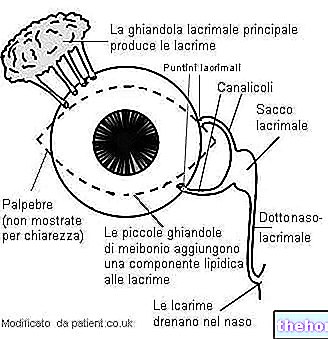Generality
The epicanthus is a muscular-cutaneous fold that originates from the upper eyelid and runs covering the inner corner of the eye.

Epicanthus is often seen in children with an enlarged nasal root (flat nose) and may be associated with incomplete development of the craniofacial mass. However, when it persists in the adult, the epicanthic fold should be considered as an anomaly.
If the epicanthus covers part of the eyeball, it can simulate a squint and sometimes requires surgical correction.
Appearance and characteristics
The epicanthus is a semi-lunar fold, which tends to dominate part of the anterior surface of the eyeball, mainly at the level of the medial canthus (note: less often, the epicantial fold can be located in a central or lateral position).
With respect to the eyelid opening, the epicanthus descends from the orbital region from the upper eyelid and runs until it is exhausted in the skin of the lower one, near the nasal border.
The epicanthic fold is almost always bilateral.
The epicanthus is typical of early childhood and tends to disappear with puberty.
One of the main anatomical parts of the face closely related to the epicantial fold is the nose. In the first years of life, if the nasal root - not yet perfectly developed - is flattened and wide, the palpebral commissure may be further away than normal and the formation of an epicanthus is more likely. Usually, these facial features tend to disappear with growth, approximately around 5-6 years of age, when the conformation of the nose is being completed.
Epicanthus pseudostrabismus
During childhood, the epicanthus is often synonymous with pseudo-strabismus (or pseudo-esotropia). If the fold partially covers the sclera, that is the white part of the eye, in fact, it can give the impression that the ocular axes are deviated, therefore it can simulate the presence of a squint.
The false perception of ocular misalignment occurs above all during the horizontal movements of the gaze, that is when the child presenting the epicanthus looks to the side, as the distance from the inner corner of the eye seems different (in practice, it seems that one of the two eyes go more inward than the other). With growth, we tend to notice less and less this pseudo-squint, thanks to the completion of the formation of the root of the nose.
The epicanthus has no consequences, therefore, on the vision of the child. In any case, the eye examinations of control established in pediatric age are essential to evaluate the coordinated and synchronous movement of the eyeballs and the eventual prescription of corrective lenses.
Epicanthus and Mongolian fold
Oriental eyes are characterized by the presence of epicanthus-like eyelid folds, defined as Mongolian folds. These are to be considered as a normal somatic feature.
The Mongolian plica is observed, in particular, in Asians, Native Americans (or Amerindians), Bushmen, Berbers, Inuits and, occasionally, in some European populations (such as Sami or Lappóni).
Associated pathological conditions
Epicanthus may present as an isolated congenital alteration, but is sometimes associated with eyelid ptosis, epiblepharon (condition in which a horizontal skin fold crosses the upper or lower eyelid) and blepharophimosis (reduction in the width and width of the eyelid rim ).
The bilateral epicantial fold is frequently found in trisomy 21 (or Down syndrome): in the past, this disease was called Mongoloidism due to the facial similarities shared with the Mongolian population of Blumenbach.
Epicanthus can also occur due to prenatal exposure to alcohol (fetal alcohol syndrome) and in newborns with "Cri du Chat" syndrome, due to the deletion of the terminal portion of the short arm of chromosome 5 (monosomy 5p).
Other conditions in which epicantial fold may be observed include Zellweger syndrome, phenylketonuria, Turner syndrome, Williams syndrome, and Noonan syndrome.
Diagnosis and treatment
Clinical evaluation is usually sufficient to diagnose epicanthus.
The presence of the fold can partially hide the eye in some extreme positions of the gaze. Therefore, when the epicanthus is excessively accentuated and disturbs the vision, it can be corrected surgically.




























